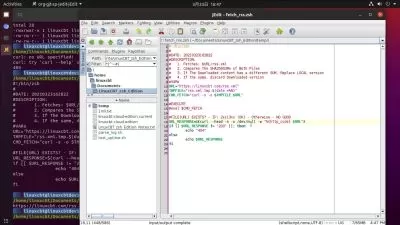Unlocked - Secrets to Time Synchronization on a Linux VPS
M F Faruqi
2:47:35
Description
How to Install, Configure & Track Chrony - The Right Way
What You'll Learn?
- Describe why the inclusion of The Leap Seconds in UTC is important to keep time in sync with The Universe.
- Describe the NTP Daemon, Systemd Timesyncd Service, and Chrony, along with their shortcomings and advantages.
- Learn how to Remove NTP Daemon and Systemd Timesyncd Service.
- Install Chrony and Enable Logging.
- Add additional timeservers to Chrony's configuration for resiliency and redundancy.
- Describe NTP Metrics such as Residual Frequency, Skew, Root delay, etc.
- Explain NTP Metrics such as Poll, Reach, LastRx, Margin of Error, etc.
- Use the gathered metrics to select superior timeservers to achieve better time accuracy for your VPS.
- Stress test Chrony to understand its time correctional behavior.
Who is this for?
What You Need to Know?
More details
DescriptionThis course is for anyone who runs or manages a Linux server.
For any Linux-based server, time management is one of the most critical and unfortunately often the most neglected part of the System Management Strategy. Every server must be able to properly synchronize time from a number of Internet Time Servers to keep the right time. If it fails to synchronize time from a time server then it has to rely upon its own motherboard based clock for timekeeping. The tick generator for the motherboard clock in most cases is a crystal oscillator.
The frequency of this crystal oscillator is not constant. Manufacturing variances and temperature differences are two of the major variables that affect this clock frequency, and gradually the system time that depends upon the motherboard clock starts to diverge. This non-perfect behavior of the System clock is also called Clock Drift. Even a few milliseconds clock drift per day may accumulate to a few seconds or even minutes over a few months.
You can relate this clock drift to a time bomb ticking away which can explode any time. And when it explodes bad things start to happen which may include:
Failure to run automated processes like order processing, data backups, or even database server crashing. And once the database server crashes all the dynamic websites hosted on a server also crash.
Data loss such as backup programs saving out-of-date versions of files, instead of the latest versions.
Compromised security such as SSL certificates failing to authenticate or failing to renew that may result in websites downtime.
Log files becoming inaccurate resulting in an inability to retrace hacking attempts.
These issues may bring up legal liabilities to a business which may result in financial losses as well as in the loss of business credibility.
This course has been prepared so that your server may reliably synchronize time from multiple timeservers, have time synchronization redundancy and have up-to-microsecond time precision.
For that purpose we shall make use of a application called Chrony. You will be guided to how to safely install Chrony, configure it, monitor it, and stress test it.
Who this course is for:
- Anyone running Linux either as a server or on desktop.
- Windows is not supported.
This course is for anyone who runs or manages a Linux server.
For any Linux-based server, time management is one of the most critical and unfortunately often the most neglected part of the System Management Strategy. Every server must be able to properly synchronize time from a number of Internet Time Servers to keep the right time. If it fails to synchronize time from a time server then it has to rely upon its own motherboard based clock for timekeeping. The tick generator for the motherboard clock in most cases is a crystal oscillator.
The frequency of this crystal oscillator is not constant. Manufacturing variances and temperature differences are two of the major variables that affect this clock frequency, and gradually the system time that depends upon the motherboard clock starts to diverge. This non-perfect behavior of the System clock is also called Clock Drift. Even a few milliseconds clock drift per day may accumulate to a few seconds or even minutes over a few months.
You can relate this clock drift to a time bomb ticking away which can explode any time. And when it explodes bad things start to happen which may include:
Failure to run automated processes like order processing, data backups, or even database server crashing. And once the database server crashes all the dynamic websites hosted on a server also crash.
Data loss such as backup programs saving out-of-date versions of files, instead of the latest versions.
Compromised security such as SSL certificates failing to authenticate or failing to renew that may result in websites downtime.
Log files becoming inaccurate resulting in an inability to retrace hacking attempts.
These issues may bring up legal liabilities to a business which may result in financial losses as well as in the loss of business credibility.
This course has been prepared so that your server may reliably synchronize time from multiple timeservers, have time synchronization redundancy and have up-to-microsecond time precision.
For that purpose we shall make use of a application called Chrony. You will be guided to how to safely install Chrony, configure it, monitor it, and stress test it.
Who this course is for:
- Anyone running Linux either as a server or on desktop.
- Windows is not supported.
User Reviews
Rating
M F Faruqi
Instructor's Courses
Udemy
View courses Udemy- language english
- Training sessions 8
- duration 2:47:35
- Release Date 2024/01/12










